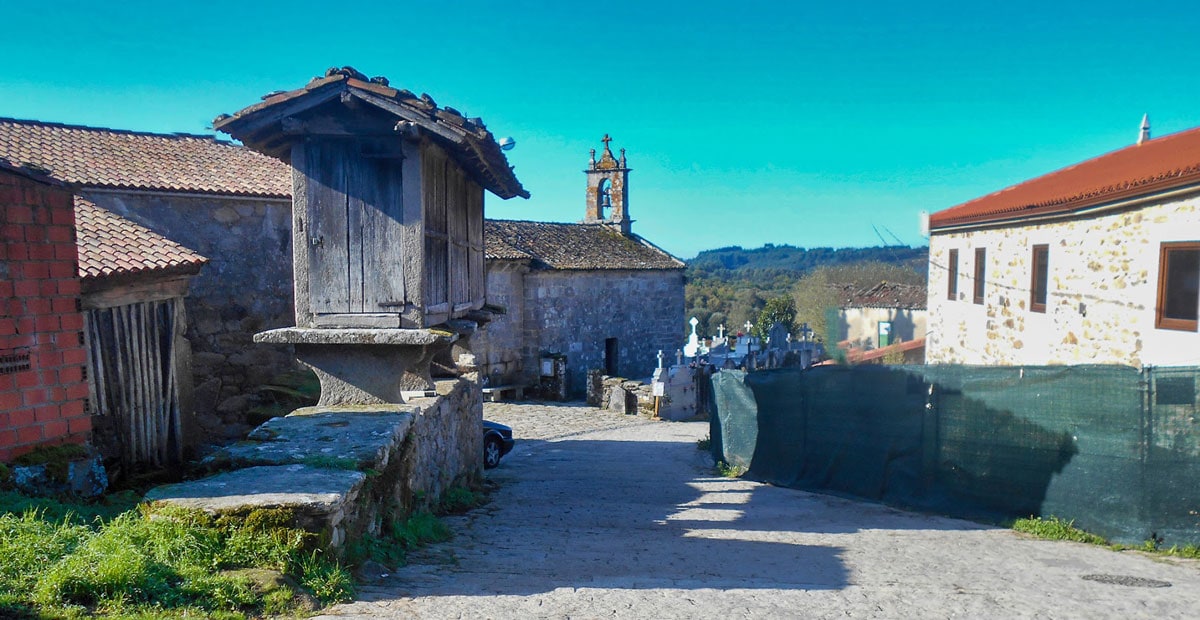
Go World Travel is reader-supported and may earn a commission from purchases made through links in this piece.
One day, while looking for a destination for a day trip from Beziers, France, I found the Abbaye de St. Marie de Fontchaude. It was not far away and was in a small hamlet surrounded by vineyards. My friend, Charles, and I decided to visit.
Way off the tourist trail, the church and abbey were unlocked for us by the caretaker. The small statues in the chapel were covered with a dark red cloth as this was the season of Lent.
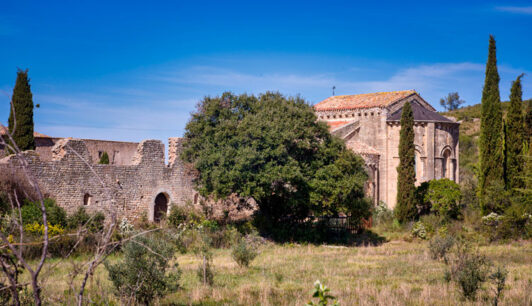
We were the only visitors and enjoyed the solitude of such a setting. It is a well-preserved twelfth-century Roman church with both standing arches and tumbled arches in the garden.
Outside I noticed a stone fountain with water dripping from the brass faucet, and into the stone, a scallop shell had been carved. The fountain was for pilgrims in need in water centuries ago and now.
“Charles,” I said, “we are on the Camino de Santiago.” That afternoon I was already making plans in my mind for my own pilgrimage.
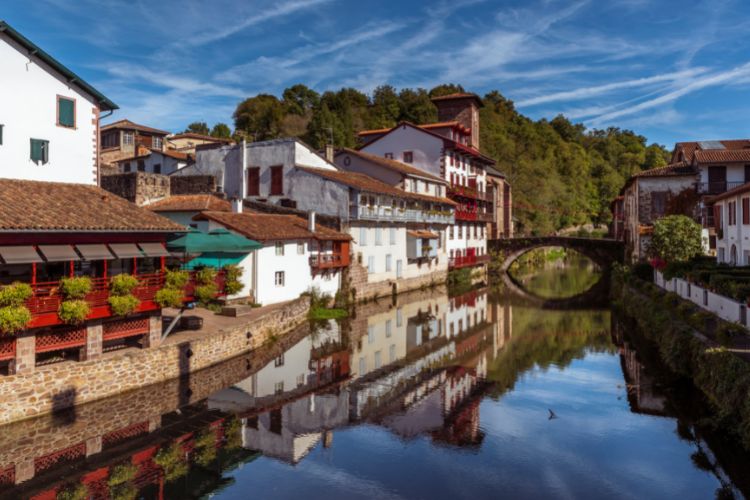
Starting the Camino de Santiago in St. Jean Pied de Port
Four months later, I got off the train in St. Jean Pied de Port, the starting point of the Camino on the French side of the Pyrénées. It ends in Santiago de Compostela, 794km / 500 miles away in Spain.
October weather prevented me from doing any more than 254km/158 miles, but as was often repeated to me by other pilgrims, “This is your Camino. You do it as you want.”
I was prepared with a light backpack, hiking poles, comfortable walking shoes, hiking pants and shirts. Also, inside the backpack were various light sources, a guidebook, ecological soap, a quick dry towel, a pair of gloves, a camera, a notebook, a phone with no GPS, a map from the guidebook and a lightweight Eddie Bauer jacket. Loaded with these supplies I headed towards the Pilgrim Inn where I would spend the night.
Early the next morning, I went to the Camino office to get my pilgrim passport. This would be stamped along the way to prove that I had walked the required number of kilometers to receive my pilgrim certificate in Compostela.
I also arranged to have my backpack transported to the monastery at Roncevalles, Spain, on the other side of the Pyrénées, where I would spend the night.
This transport service is one that many pilgrims use to literally lighten the load during the day. They then arrive to find their packs waiting for them at an inn or monastery where they had made reservations for the night.
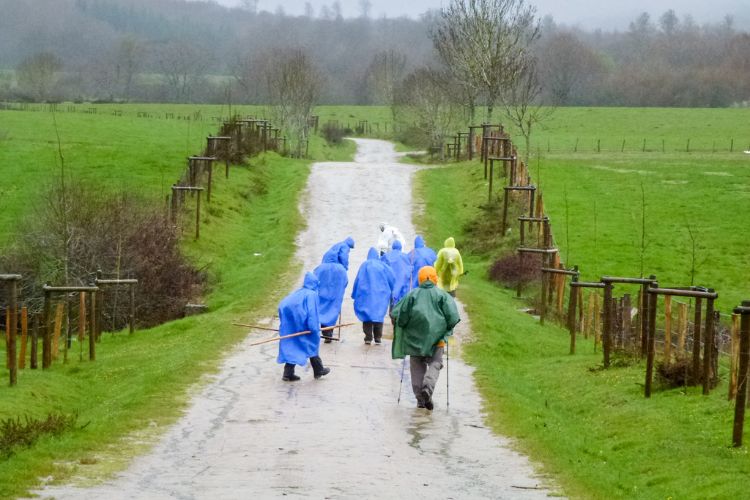
Day 1 of Walking the Camino de Santiago
The weather was clear and sunny on arrival at SJPDP, but it changed overnight. Cooler temps, fog and a light drizzle accompanied me that day. This meant crossing the Pyrénées on foot in less-than-ideal conditions.
I made a stop, as many do, at Orisson, 7.6 km into the mountains. Here I filled my water bottles, had a hot cup of tea and enjoyed a delicious, much-needed hot bowl of soup.
The ascent to the summit was difficult. However, my pheromones were in full swing thinking about what I had just accomplished. I had no idea the descent would be so much worse. It wasn’t really a descent. Too often it was an ascent before a descent and then another ascent.
The fog rolled in, then the rain, not heavy rain, but enough to make walking uncomfortable. I had a plastic raincoat in my bag and was able to keep my backpack and most of me dry. Up ahead I saw a couple and I was happy to have others within sight. At one point I caught up with them and found they were Castilian Spanish.
I walked on a little, but at some point, the scallop shell marker sent me off the road, then around a fence in the mud. I waited for the Spanish couple, and the woman could see I was waiting for them. “Tranquilo, Señora, tranquilo.” Being tranquilo when we seemed to be lost and there was no one to help us was not easy.
We made another detour, following the scallop markers and I walked on ahead. There was a small stone house, a refuge for the pilgrims. Two other walkers came in followed by the Spanish couple. My fingers were so cold I couldn’t use them and had to ask one of the others to unzip my pack so I could share my trail mix.
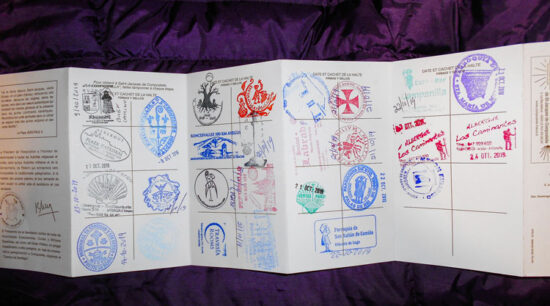
Tranquilo to Tramposa
Up and down more hills, my shoes covered in mud, I was cold but had no choice but to continue. I came to a road, which led to a forest, foggy and beautiful. At some point, I managed to take out my camera. I was a good distance ahead of the Spanish couple at that point and just kept going down.
Eventually two men appeared and I said to them in Spanish: “He estado caminando y caminando, pero no puedo salir!” (“I have been walking and walking, but I can’t get out!”.) The response was: “Trente minutos, más or menos” (thirty minutes more or less.) Sure enough, not long after, I saw the welcome sight of the monastery.
It had taken me 11 hours and 16 difficult miles to get there. Once again, I heard, “Tranquilo, Señora”, this time from a pilgrim helper.
She got me settled in, I got my Camino passport stamped, and found a room with 59 other pilgrims. I showered, skipped dinner and got into bed at 8:30, exhausted but exhilarated that I had just crossed the Pyrénées on foot.
The next morning, I became a tramposa, a cheater, because I booked a room in a hotel, went there by taxi and took a day of rest. Tramposa still, I took the bus to Pamplona, but not before meeting, once again, the Spanish couple. They stayed in the same town, but had hiked to Pamplona, and laughed about meeting again as we did.
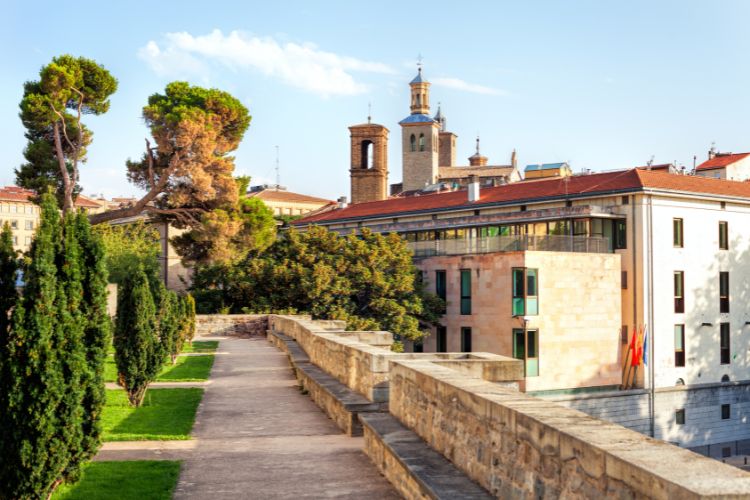
Respite in Pamplona
Upon arriving in Pamplona, I walked with a young Irish woman. Together we found the Albergue, a Pilgrim Inn. I checked in and just walked around Pamplona, getting used to this new experience and thinking about where I was. We later met for lunch with other pilgrims on the square in front of the inn.
When we had finished eating a fellow pilgrim said he would show us photos on his phone of his feet covered in painful blisters. I had heard of this happening, that pilgrims sometimes had to take a couple of days off to heal their feet. This man’s feet were not a pretty sight.
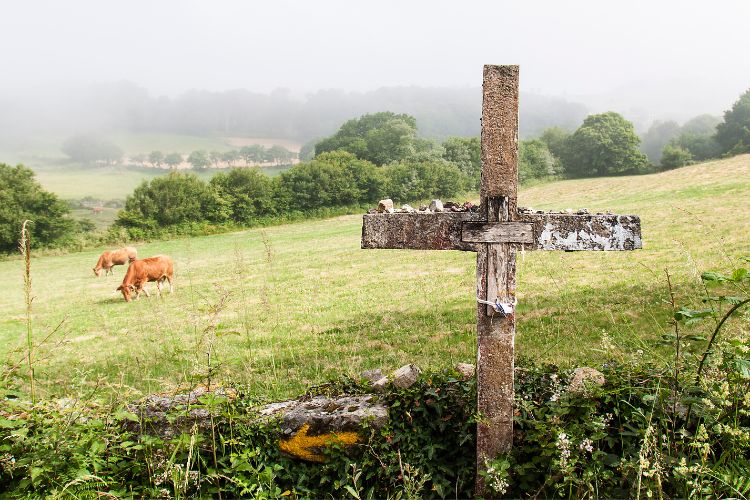
Conversation with a Catholic Priest
On my way from Pamplona to Uterga, (no bus this time), I walked with an Australian Catholic priest. He told me he was walking the Camino to strengthen his faith.
I felt at ease talking with him about my Roman Catholic upbringing. A part of my upbringing which I still view with dismay – beliefs reinforced by guilt and fear of punishment.
Certainly, practices and beliefs have changed. But in my youth, girls couldn’t go past the altar railing and memorizing the catechism was considered learning. The fear of spending eternity in hell for eating meat on Friday or not going to church on Sunday was among the many fears in our young Catholic lives.
Our discussion, however, made me consider going back to the Catholic church. But I gave up that idea when I told him about having communion in Assisi, Italy. I was so moved by the service, the chanting, the incense and just the familiarity of it all.
He asked me if I had gone to confession before, which I hadn’t. Apparently, I should have. I wondered what I could possibly confess at that point in my life. Nonetheless, my conversation with him made me appreciate how strong his faith was.
I needed a break from our fast walking after about 90 minutes. In parting, I told him of my belief in angels. How, on the night when my second grandchild was being born, I drove a new route to my daughter’s house at night and I just knew that the car in front of me was leading me there. Which it did.
I told Fr. Michael that I will think of him as an angel, too, and my eyes welled a little. Such a meaningful conversation and I had only been walking the Camino de Santiago a short time.
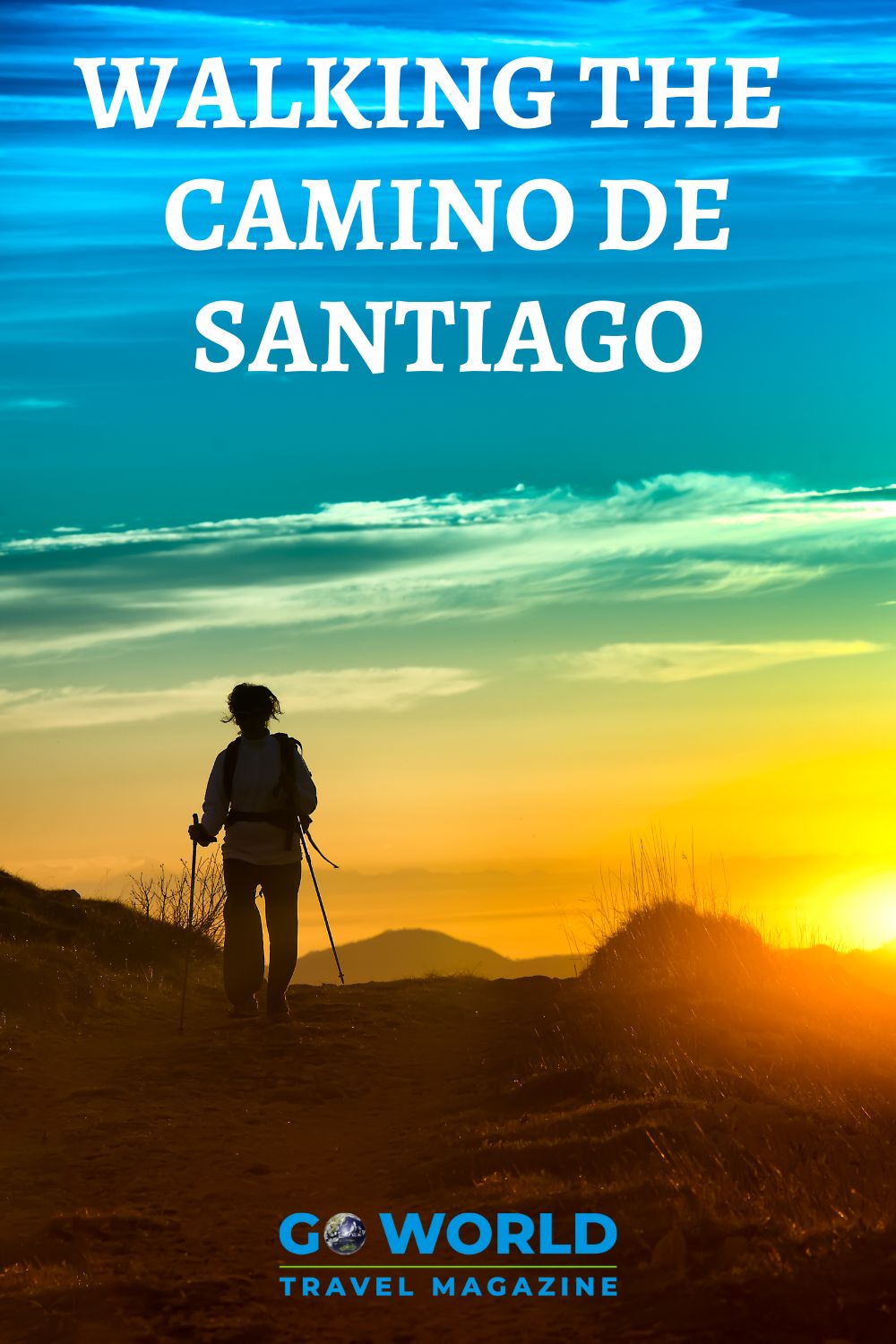
Communal Dinners and New Friends
My next stop was in Uterga where I had dinner with Angry Hanna, as I called her in my mind. Hannah had started her pilgrimage at Le Puy en Velay in France.
Her intention was to end in Compostela (1,515 km/941 miles) to make peace with God. She didn’t explain what she meant by that. Hanna was edgy, spoke little and then just left as soon as she finished dinner.
Two Israeli women hiking just a short part of the Camino were also at dinner. Both of whom laughed and called Donald Trump their friend. I thought it best not to make any remarks. I also met Alice, a Brazilian woman about sixty years old.
She was in the bunk across from mine and had badly hurt her knee and could not walk. Knowing how it feels to be sick and alone in a foreign country, I stayed with her. I used what remained of my knowledge of Spanish, she answered in Portuguese, and somehow, I got most of what she was saying.
In my backpack were a few St. Francis crosses, called Tau. St Francis designed these as a sign of conversion from the wild times of his youth to a man who helped the poor and reminded others not to think only of themselves.
Alice cried when I gave a Tau to her and then she sang two songs to me in Portuguese about St. Francis. It was a touching moment for me. A reminder of the strong beliefs in God that some people on the Camino carry with them. Alice and I still keep in touch and she often reminds me of her invitation to visit her in Brazil.
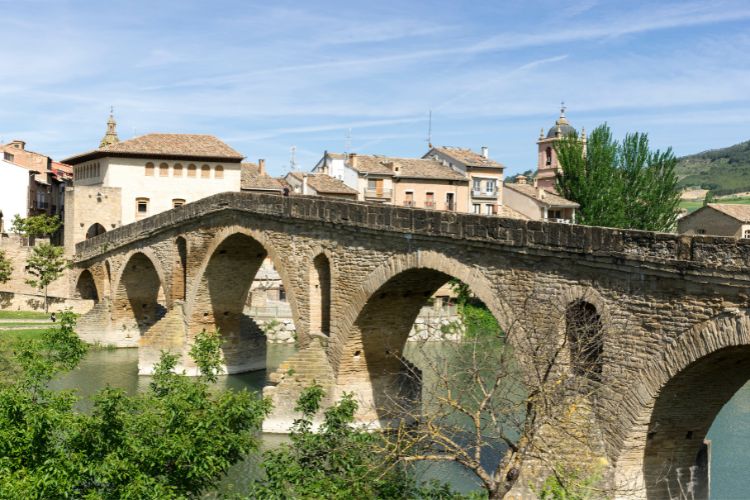
Puente la Reina
A day of rest is suggested for the pilgrims and I took mine in a small hotel before heading to Puente la Reina, (Queen’s Bridge) the following day.
I stayed in an Albergue in a room with four talkative young women, whose conversation I greatly enjoyed. They were sharing their plans for the future and taking time now to walk part of the Camino.
The main street of Puente la Reina leads to the six-arched Romanesque bridge. It is lined with churches, shops, small restaurants and cafés, all built of stone.
I was beginning to understand why many thousands of pilgrims, perhaps millions crossed that bridge. Possibly to strengthen their religious faith, make peace with God, give thanks or maybe all three.
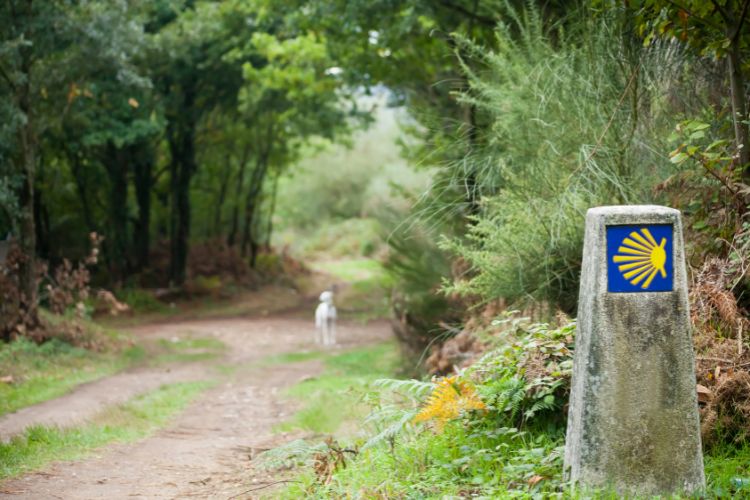
Casa Magica
My next stop was the Casa Magica (the Magic House) in Villafuerte. It’s a pilgrims’ hostel housed in a building over 400 years old. Some of the hostels provide dinner and I shared a delicious vegetarian meal with two others. One was a quiet young woman from Korea. The other was a young man from California who said he had become addicted to walking the Camino.
He was not able to take two or three months off to walk the full Camino de Santiago all at once. So, he returned each year to pick up where he had left off the year before.
The Casa Magica is spacious with a place to sit outside in the sunny courtyard or take the time to meditate in the old room entered under an arch. I stayed there an extra night even though it was not raining.
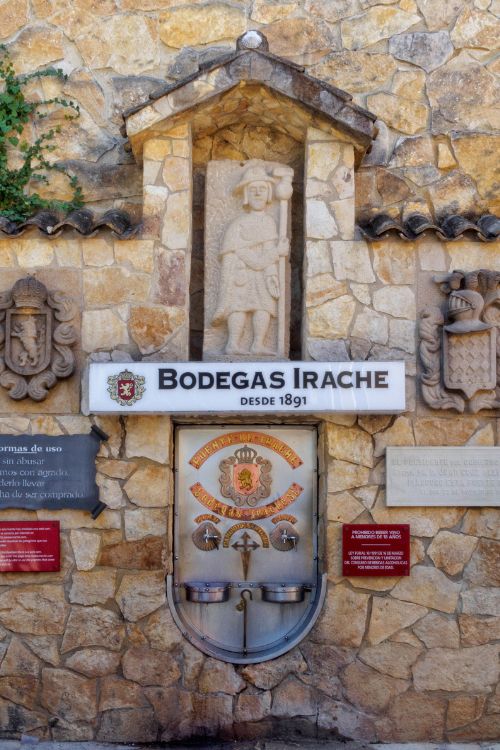
Water to Wine Fountain
As I was writing in my journal in Casa Magica, three women came into the room and I spoke with one of them. She was a Brazilian married to an American and was now living in northern California. We shared a lot about our reasons for walking the Camino.
The next day I walked solo to the fountains in Irache. One was filled with water and the other with red wine. This is free for pilgrims and anyone else who symbolically wants to enjoy water from one fountain changed into red wine in the other.
I once again became a tramposa because I took the train from Villafuerte to Sarria for the final 100 km (62 miles.) To do so I was helped by another angel.
The owner of the Casa Magica told me where the bus stop was to get to the train, but it was a Sunday when fewer buses were available. A man in his car stopped and saw that I was not only a pilgrim on the Camino but that I was a lost pilgrim. He offered to drive me to the bus station.
Normally I might hesitate to take a ride from a stranger, but something told me I would be safe. He drove me right to the bus station, another angel on the route.
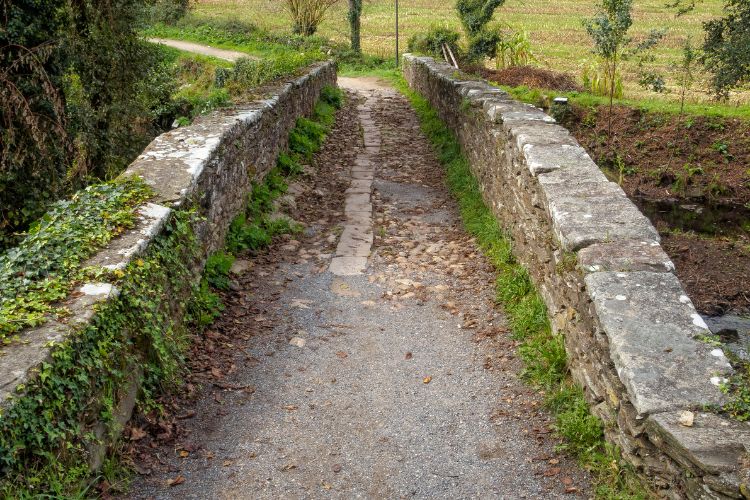
Taking a Break in Sarria
The train to Sarria took most of the day. It was a nice break from walking, giving me time to enjoy the scenery from a train and to reflect further on what I had seen and done so far. It was on this journey that I met Rachel from Iowa. Together we found the monastery where we planned to stay. There were lots of beds, but not a lot of pilgrims.
When I got up in the dark the next morning, it was raining. Neither of us wanted to spend the day walking in the rain and cold. So instead, we enjoyed a delicious lunch with a glass of local white wine. Early the next morning, we left before sunrise and spent the next two days together.
Rachel was part of an intentional Catholic community. She explained it is a place where people live in close proximity to one another. Rachel lived in a house shared with several others.
The main idea is that people need such proximity so that they are better able to help one another when the need arises. Somehow Rachel had gotten ahead of the group she was walking with. I was glad to have her company for a couple of days until she found her group again.
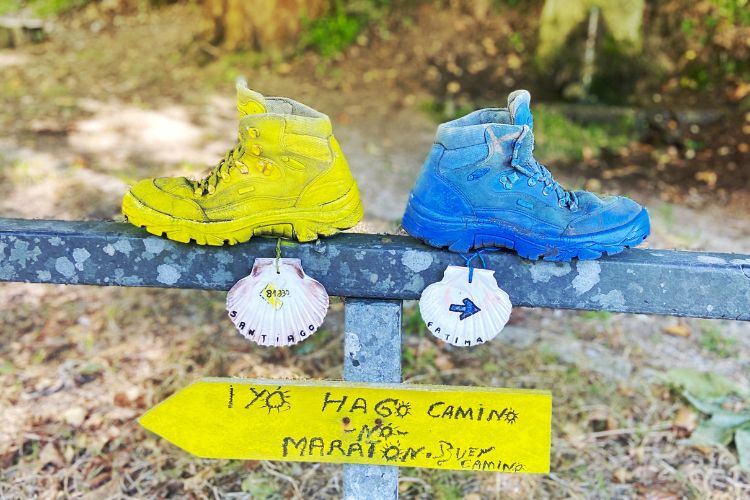
Seemingly Endless 300 Meters
Who needs GPS on a phone when the Camino is so well marked and I had a good map? Somehow on my way to Melide, I ended up on a highway. There wasn’t a lot of traffic, but enough cars and large trucks to scare me as I walked on the narrow shoulder.
I found someone to ask if I was on the Camino. He said yes, to continue for 300 meters, and then I’d find a left turn. No left turn was found.
I asked a man in a truck and got the same answer: “300 metros, Señora.” Then I saw a man leaving his house, so I walked up to him and was once again told – “300 meters.” I am sure these people were correct and were often asked the same question by passing pilgrims.
Maybe I was thinking in feet instead of meters. Eventually, I saw two pilgrims so I crossed a dry ravine and followed them for a while. After walking a total of 14 miles I found Melide and felt good about it.
Off I went before daybreak the following morning. That day I walked only 4 miles, as my feet and knees needed a break from the 14 miles of the previous day.
As it often is on the Camino, the walk was beautiful. I saw the sunrise and walked through a forest of eucalyptus trees, graceful in the early morning light. I also passed through many “tree tunnels” as I called them.
People were friendly and the phrase “Buen Camino” was offered often along the way from the Pyrénées to Compostela. I loved stopping in the little churches or chapels, meditating for a while, and lighting a candle for my family. It felt good to feel I was part of something. And that something was watching over me even while lost on a busy highway.
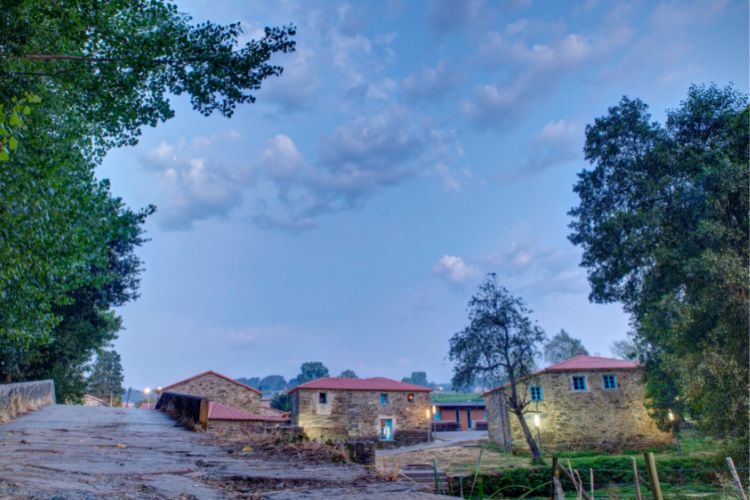
How to Say Bedbug in Spanish – Chinche
I entered the lovely village of Ribadiso by a medieval bridge. A friend in an email teased that I didn’t suffer on the Camino. It’s true I used a transport service for my backpack, enjoyed local foods and wine and stayed an extra day in a hotel or Albergue if it rained. But I made good use of that time to edit my photographs, catch up on emails and write in my journal.
From time to time, I would scratch my right hand and lower arm as I was writing. I didn’t think much of it until I noticed a tiny spot of blood on the sheet later.
Also, when I stood up, I saw a small, black insect. I’d read about bedbugs – chinches – and now I was experiencing them. As I undressed for bed, I saw a line of bites on my shoulder and verified online that these were, in fact, bites from chinches.
I left a note for the management the next morning. Then I went to a pharmacy for a remedy because the itching and welts were awful. I was about to show the pharmacist the bites, but he just smiled and said, “No es necesario, Señora”. He knew what they were and gave me a salve. So, I could now email my friend and tell her that I did finally suffer on the Camino.
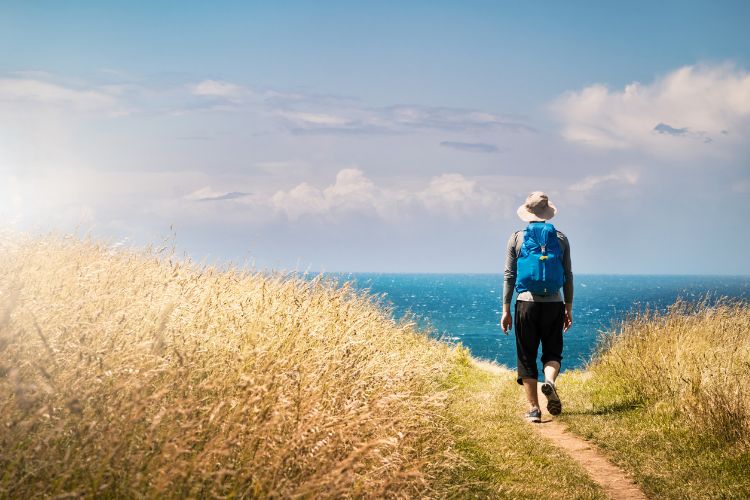
“I’m Married”
As I was readying my backpack in Pamplona at the beginning of my walk, I had spoken with the man across from my bunk. A frequent question was to ask where one was from. I explained I was from the U.S. and he said he was Dutch.
Then he said, “I’m married. My wife is in the shower.” I wondered why he shared that piece of information. I wished him a Buen Camino and left for my next stop.
As I was approaching the steep hill leading to the famous sculpture of pilgrims called El Alto de Perdón, the Hill of Forgiveness, I saw a man sitting alone.
He was the only person there and we began to talk. He said that he was from the U.S. and added; “I’m married.” I asked him to take a picture of me, as most pilgrims do, within the sculpture. I wished him a Buen Camino and went on my way.
On my last evening in Compostela, I took a walk into town. On my way back to the monastery, I couldn’t remember the way. I asked a man on the street corner, also waiting for the light to change. We began walking together and he told me he had walked the Camino as well, that he was from Mexico and that he was married.
When I was back in the U.S., I told these stories to a friend who has done several parts of the Appalachian Trail. He laughed and said it could be that, like the AT, there are what is known as ‘trail husbands’.
Apparently, couples hook up while they are on the trail and then say goodbye. I don’t know, but I did wonder if the concept of a trail husband exists on the Camino. I may not find the answer to that question but my friend’s explanation made me laugh.
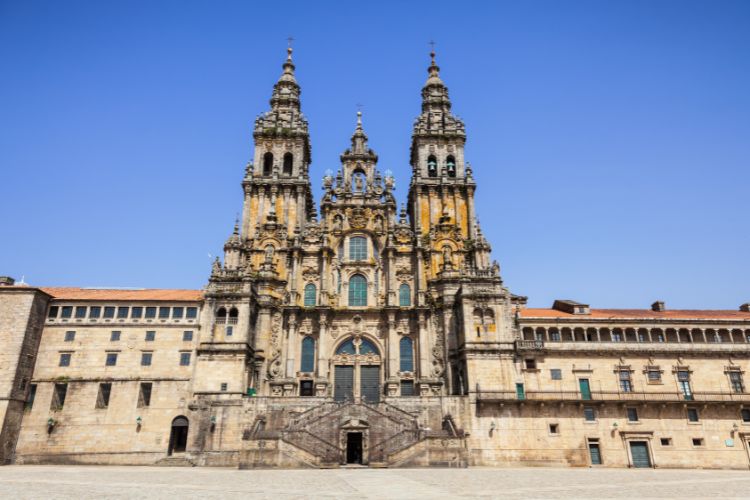
Arriving in Compostela
Another pilgrim and I arrived at the gates of the large monastery for pilgrims at the same time. He was Canadian and had just finished all 941 miles, having started in Puy en Velay in France.
I would have liked to talk with him in depth about his experience. But I felt he needed his alone time to let the experience of the Camino wash over him. I also needed that time despite my shorter distance.
I checked in, then walked to see my destination – The Cathedral of St James of Compostela. The square in front of the cathedral was huge, the space needed for the materials and workers building the cathedral in 1075. I walked to the furthest point on the square without looking to my left as I wanted to take in the whole scene.
As I turned to look, the cathedral was as beautiful and awe-inspiring as I had imagined it would be. And to think it has been standing there since the Middle Ages.
Like all arriving pilgrims, I got in line to hug the statue of Saint James at the altar to give thanks for the safe arrival. Describing such a moment is difficult. I think it is something that must be experienced to really understand it.
Thousands, maybe millions have done the same as evidenced by the worn stone of the scallop shell on the floor leading to St. James. I stayed in the cathedral for some time, taking it all in, marveling at where I was and how I had gotten there. I could call the experience an adventure, but it was much more than that.
Even now there is a dreamlike quality to it all. Memories of the dark mornings, the sound of my trekking poles, the beautiful scenery and the medieval bridges. Also, the Camino markers, conversations with other pilgrims and statues of Saint James everywhere.
The thought of waking up in the morning and all you must do is have breakfast, reorganize your backpack and be on your way. With no goal other than to get to the next pilgrim inn. What a wonderful way to start a day. And what a wonderful way to end a walk to Santiago de Compostela, at the Cathedral of St. James.
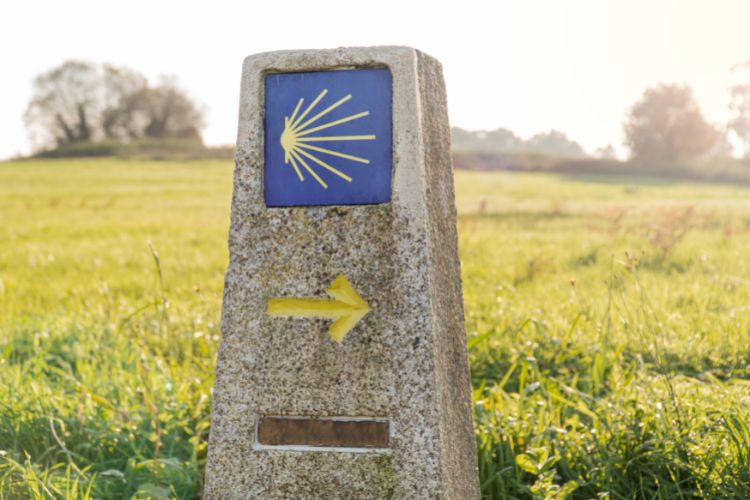
Some Reflections on Walking the Camino de Santiago
The metaphor of the Camino being a piece of life is very appropriate. There are ups and downs, difficult times and good times. People were kind and angels appeared when I needed them.
One of the angels carried a blue umbrella and helped me find a hotel I was looking for in the rain, well hidden behind a church. The lady with the blue umbrella smiled widely when we saw that this was the right place. I thanked her and said, “Es un angel, Señora.” She was an angel, something I have come to believe in.
Being on the Camino was not always easy. There was the first day when I crossed the Pyrénées with the cold, the wind and the mud.
I had thought that I’d never find the end of the forest leading to the monastery in Roncesvalles. But I did, and being there was a new beginning. Looking forward to whatever might come my way over the next weeks.
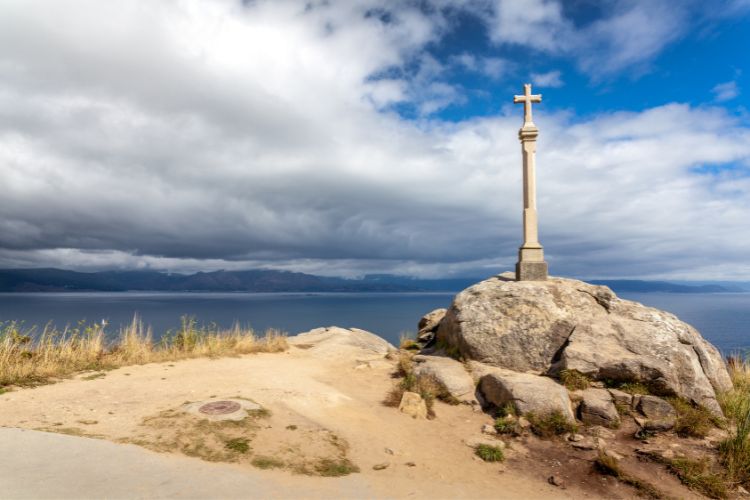
Many Reasons for Walking the Camino de Santiago
Each person I spoke with over those weeks had their reason for walking the Camino de Santiago. Many were religious, others looking for insights or were there just for the experience itself.
I am not a religious person, but I think it would be impossible not to feel the spirituality of the Camino. It was a feeling that came over me during conversations and how forthcoming others were about their lives. People I will never see again.
An American nurse told me she was walking because she had had access to drugs in hospitals which she abused. Finally, she realized the harm she was causing to herself and her family. She felt that the Camino would keep her from returning to her addiction.
Such a conversation would never happen with someone we might meet on any street. But the Camino is not just any street. It is a place of peace, beauty, history and friendliness. Plus it leads to Compostela. The field of stars, where one can give thanks for having reached it or celebrate one’s arrival there as one wants.
I miss the Camino, the sound of my trekking poles, greetings of Buen Camino and getting up some days before sunrise and seeing the light and colors change. The alone times didn’t bother me at all. I sometimes even preferred them. I enjoyed the uninterrupted time to think, just time to reflect on my life and where I would like it to go.
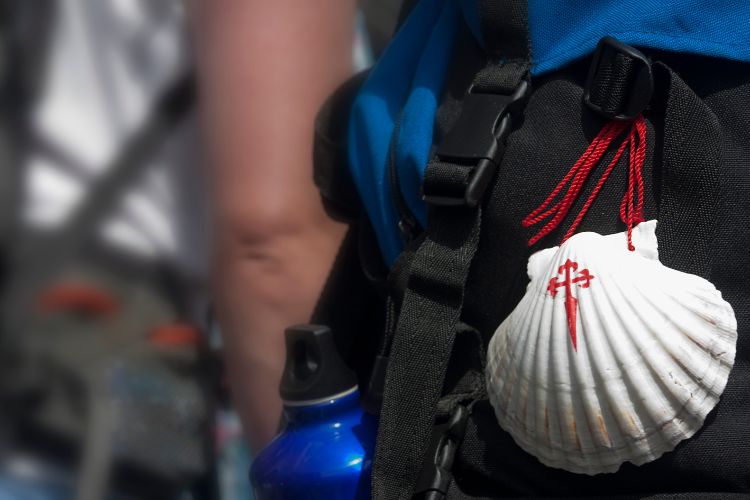
Fond Memories and New Beginnings
The scallop shell is the symbol of a rebirth, a new beginning. I am reminded of that each time I look at mine. As my grandkids have begun to graduate from high school, one of my gifts to each of them is a scallop shell. I hope it will remind them of their new beginning and other new beginnings that will come to them throughout their lives.
After Compostela, I took the bus to Finisterre, the end of the earth. Here I saw the Atlantic on a blustery, windy day. At Finisterre, I put down a note that a dear friend of mine in the U.S. had asked me to place for her under one of the peace markers.
My token was a stone, light purple in color. I had picked it up in the desert when I was a teacher of English in Saudi Arabia. After kissing the stone I placed it on the ground. I gave thanks for my time there, for all the adventures, the people I met, the friend and lover I had plus all the memories I now carry with me.
I also left a small, opaque stone in the shape of a heart. It had been on my dresser in my Maine island home. Finisterre seemed the right place for it. My eyes welled a little as good memories came to mind, ones that will make me smile forever.
Dreamlike days, magical days, like those on the Camino, in Saudi Arabia, and on the coast of Maine. Maybe that is the gift that the Camino gave me – a letting go of difficult past times and thinking now only of the good ones and those to come.
Best Tips & Tools to Plan Your Trip
Author Bio: As a child, Ava was fascinated by world maps, which later turned into travels to many parts of the world. She has worked in several African countries, created a microcredit group for women in Honduras, and did a volunteer photography gig for a clinic for a Mayan community in a remote mountainous region of Guatemala.
Recently, she hiked along the Camino de Santiago in Spain and in France, and traveled in Morocco, fulfilling a childhood dream of walking barefoot in the Sahara and another of seeing the aurora borealis in Iceland.
Ava is the author of the recently published “Where in the World is Grammie Now?”, a book for young readers to teach them about Saudi Arabia, a country not often studied in middle school curricula. She has also authored a book on her four years in Saudi Arabia, “Wanderlust, A New Lease on Life in the Kingdom of Saudi Arabia.
Ava makes her home in southwest France and on a remote island off the coast of Maine, USA.
- Life of a Champion: Exploring the Muhammad Ali Center in Louisville - April 19, 2024
- What It’s Like to Live as an Expat: Lake Chapala, Mexico - April 18, 2024
- Top 5 Spots for Stargazing in North Carolina - April 17, 2024

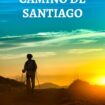
Thanks! We have made that update.